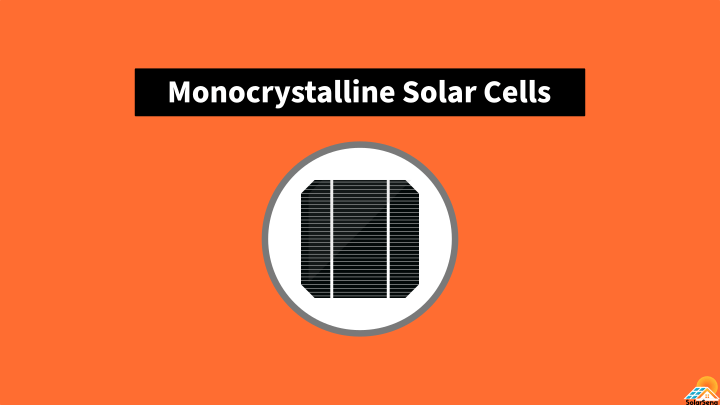Solar cells are photovoltaic devices that convert light into electricity. One of the first solar cells was created in the 1950s at Bell Laboratories. Since then, scientists have developed numerous types of solar cells. One of the most popular of them is monocrystalline solar cells. Monocrystalline solar cells have gained great attention since their development because of their high efficiency. They account for the highest market share in the photovoltaic industry as of 2019.
What are monocrystalline solar cells?
Monocrystalline solar cells are solar cells made from monocrystalline silicon, single-crystal silicon. Monocrystalline silicon is a single-piece crystal of high purity silicon. It gives some exceptional properties to the solar cells compared to its rival polycrystalline silicon.

You can distinguish monocrystalline solar cells from others by their physiques. They exhibit a dark black hue. All the corners of the cells are clipped; this happens during the manufacturing process. Another distinguishing feature is their rigidity and fragility. You will never find monocrystalline cells in a flexible form because of their large thickness.
Working theory
The working theory of monocrystalline solar cells is very much the same as typical solar cells. There is no big difference except we use monocrystalline silicon as a photovoltaic material.
The diagram below is the cross-sectional view of a typical solar cell. The solar cell is formed by the junction of n-type mono-Si and p-type mono-Si. The n-type mono-Si (in red) is the phosphorus-doped layer, while the p-type mono-Si (in aqua blue) is the boron-doped layer. The combined thickness of these layers ranges in hundreds of micrometers.

When the light of suitable frequencies falls at the p-n junction, a large number of charge carriers are generated. The negatively charged carriers, electrons, enter into the circuit via the n-type layer, whereas the positively charged carriers, holes, move into the circuit via the p-type layer.
The efficiency of monocrystalline solar cells
The lab efficiency of monocrystalline solar cells has gradually increased over time—we can see in the following graph. There has been an 8 to 10% jump in efficiency in the last two decades.

The typical lab efficiencies of monocrystalline cells are between 20% to 25%. In 2017, the Kaneka Corporation achieved the current highest efficiency record of 26.7%.
Note: The efficiency of solar cells is different from the efficiency of solar modules. Solar cells will always be more efficient than their modules. Even though monocrystalline solar cells have reached efficiency above 25% in labs, the efficiency of monocrystalline modules in the field has never crossed 23%.
Advantages of monocrystalline solar cells
There are some advantages of monocrystalline solar cells over polycrystalline solar cells. They are as follows:
High efficiency
Monocrystalline silicon is homogeneous material. Its thermal, electrical, and crystal properties are the same throughout the material. Furthermore, there are no internal breaks or grain boundaries. Thus, when the charge carriers flow through monocrystalline cells, they receive minimum internal resistance. It maximizes the energy transport efficiency within the material. It’s why monocrystalline cells have always been more efficient than polycrystalline cells.
Temperature resilience
Whenever the current passes through a conductor, there is the generation of heat in the conductor due to resistance. This phenomenon is the Joule heating effect. The amount of heat produced is directly proportional to temperature or resistance. So, as temperature increases, solar cells will produce more heat. This heat is undesirable and deteriorates the overall efficiency of solar cells. Since monocrystalline solar cells offer lower resistance, at higher temperatures, they perform much better.
Long lifespan
Monocrystalline solar cells, when handled with care, can last for more than 25 to 30 years. Their long lifespan makes them suitable for long term investment.
Good aesthetics
Its black color and glossy look of the solar cells are modern and attractive. They appeal more to people than polysilicon cells.
To read more on the comparison between the two, continue at monocrystalline vs polycrystalline solar panels.
Disadvantages of monocrystalline solar cells
Although monocrystalline silicon has advantages, like high efficiency, they also have some undeniable disadvantages.
High cost
The manufacturing of monocrystal cells is more costly than polycrystal cells. In fact, they are the most expensive among commercial crystalline silicon and thin-film technology.
Rigidity
The high thickness of monocrystal cells makes them rigid. They can break into pieces if loosely handled.
Complex manufacturing process
The manufacturing process of monocrystalline cells is not very simple and is very lengthy. It makes the process more energy expensive than the process of other alternative solar cells. Moreover, the manufacturing process of monocrystalline cells produces more silicon waste than the manufacturing of other cells.
The manufacturing process of monocrystalline solar cells
As said in the previous section, the manufacturing process of monocrystalline solar cells is very lengthy and involves a multitude of steps. We can categorize all individual steps into four sections.
- Metallurgical purification of silicon
- Purifying silicon to hyper pure silicon (or solar-grade level)
- Making monocrystalline silicon ingot from solar-grade polysilicon.
- Making monocrystalline wafers and turning them into monocrystalline solar cells.
In metallurgical purification, cruel silica is chemically processed to give pure silicon. The process includes the reaction of silica with carbon to form molten silicon at the bottom of the electric arc furnace. The purity level of silicon at the end of the step is 98%.
After purifying silicon to metallurgical grade (MG), it is further processed to give solar-grade silicon. This step covers the Siemens process. The Siemens process is also a multistep process, involving chemical engineering unit operations, reaction, separation, and purification. In the end, we get hyper pure polysilicon (or solar-grade silicon). The purity of this silicon is very, very high.
How monocrystalline solar cells are made from polysilicon?
The hyper-pure polysilicon from the Siemens process is the feedstock for the Czochralski process. The Czochralski process involves the melting of polysilicon and developing cylindrical monocrystals called ingots. The homogeneity of monocrystal is decided by this step.
Later on, ingots are trimmed and cut into thin slices called wafers using the wire saw cutting technique. Before slicing ingots, manufacturers also trimmed them from all four sides. It’s squaring of cylindrical ingots. The cutting of ingots generates significant material wastage. After producing wafers, they are subjected to various surface treatments, such as printing, etching, and coating. Finally, other components like electrodes, anti-reflective coating are fixed on the surface of wafers to form solar cells.




